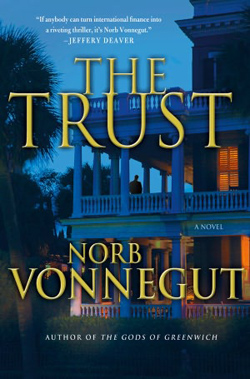 The Trust, a financial thriller, is the second novel in the Grove O’Rourke series by Norb Vonnegut (available July 17, 2012).
The Trust, a financial thriller, is the second novel in the Grove O’Rourke series by Norb Vonnegut (available July 17, 2012).
When Wall Street whiz Grove O’Rourke gets a surprise phone call for help from his friend and mentor, Palmer Kincaid, it sets off more chaos than the opening bell. Money laundering, murder, drug cartels, and kidnapping are woven into this tightly written thriller.
The Trust is a money motivated novel, and maybe there’s no one better to write one than Norb Vonnegut. Vonnegut spent years as a financial advisor on Wall Street; it shows in his depiction of the not-so-glamorous world of high finance.
We fight and yap all day. We mark our territories. And you can take it from me: we’ve forgotten more about pack behavior than London’s sled dogs will ever know.
We’re a white-shoe investment bank, a place where the elite go for smart ideas and kid-glove service. From the outside, all you see are bright people and lots of panache.
Inside, it’s a different story. We could be Goldman Sachs, Morgan Stanley, or any of the wire houses. Backstabbing. Rival coalitions. There’s nothing pretty about slimeballs. Internecine warfare is the same in every firm.
So are the office layouts. Stockbrokers get crammed into tight spaces.
No surprise given the staggering cost of office space across Manhattan. At SKC, there are 150 of us arranged in neat rows of high-tech workstations.
We make a ferocious racket: buying, selling, and nagging clients to shit or get off the pot. Throw in a dozen televisions tuned to CNBC or Fox Business, and the noise is more jarring than silverware in a garbage disposal.
Our place is a nut house. I discarded my old notions about order, because survivors are the ones who adjust to chaos.
What I liked about Vonnegut’s world is that good guys are average Joes pushed to their limits.
Look, I’m not especially big. About six feet tall, and my girlfriend says, “Grove, you could use ten pounds.” You see me and think Lance Armstrong with ginger hair. It’s not my size that works in these situations, maybe not even what I say. It’s attitude. When I hit my limit, I morph into a human wrecking ball. I become ruthless, brash, capable of flattening anyone who gets in the way. My Southern manners go AWOL. I have a temper. The trick in these situations is to threaten once. Act like a hair trigger, methodical, outcome certain, ready to snap any second . . . .
In Grove’s case, he can also take a few punches.
Suddenly, my face became his speed bag. Right. Left. Right. Left. I heard something snap. There was blood everywhere, and maybe a piece of nose. Mine. I brought up my right knee, fast, furious, dirty.
I don’t normally like when the point of view (POV) switches from chapter to chapter, but Vonnegut pulls it off. He manages to keep all the different locations updated from the right character’s perspective. Vonnegut’s attention to details made me feel like I was waiting alongside Bong in this kidnapping scene.
For the thirtieth time, maybe it was the fortieth, Bong checked his roll of duct tape. It was sitting on the passenger seat. Primed and ready for action. He had already folded back the edge, sticky side facing sticky side. Advance preparation reduced the number of screw ups.
The last thing he needed was to get stuck while wrapping JoJo.
He waited. He watched the clock. Perspiration poured from his brow.
Bong heard a car. It was JoJo’s Mercedes. There was no mistaking the custom paint job, the cream top and navy blue body. He popped the trunk and started his car, waiting for her to get out.
Bong shot out of his seat, tape in hand. Pinned her fast, his knee pushing against the flat of her back, his hands controlling her arms, dominating her.
JoJo tried to scream. Bong was too fast, too powerful, awash in a sea of adrenaline. The veins under his spider-sun tattoo bulged as he wrapped the blue duct tape around and around JoJo’s head, gagging her mouth, muffling her cries for help.
Bong coiled her wrists in blue. JoJo kicked and writhed. The Atlantic Ocean roared, drowning their noise.
Total time elapsed: thirty seconds. And as he drove away, considering the delicious surprises awaiting the very rich Mrs. Palmer Kincaid, Bong realized the most curious thing:
He felt great.
One technique Vonnegut uses to keeps the action focused on the central character in each chapter is by using deep POV to reveal their innermost thoughts:
He had no idea what “his partners” would do. They’d once held themselves out as allies. But they played by a different set of rules, and Palmer was an obstacle. He knew it. They knew it. And in their world, he was expendable.
Palmer could hear his heart beat. He could feel the perspiration running down his brow. He could smell his own fear.
Who are these people?
Vonnegut’s commitment to character development and firsthand knowledge of the inner workings of Wall Street makes this hard-to-put-down thriller a safe investment.
As a side note, I have a feeling that this is not the last we see of Grove O’Rourke. Vonnegut states on his website that he has two new ideas for the Grove O’Rourke series on the back burner while he writes a nonfiction book.
Cindy Kerschner is an avid mystery fan, freelance writer and professional cook. You can learn about her through her website: www.cindysrecipesandwritings.com.
